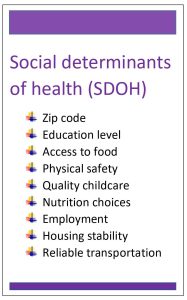Technology’s role in addressing health equity
Providing high quality healthcare to all patients is the mission for hospitals and health systems focused on improving diversity, equity and inclusion. Access to such care is an ongoing challenge made significantly more difficult by the providers’ increased adoption of digital tools and technologies.
Access to quality care is one of the CDC’s main focal areas relative to social determinants of health (SDOH) — nonmedical factors that influence health outcomes. New diagnosis codes from CDC will become effective April 1, 2023, including a code option that relates to SDOH problems with education and literacy.
Many people who are underinsured or uninsured can’t afford health plans and out-of-pocket costs of care. They may live in areas lacking high quality healthcare providers. Lack of financial resources and education on health and technology may leave many patient populations at severe disadvantage when it comes to the new ways providers are offering patient care.
Telemedicine’s pandemic rise may have improved access to remote populations, possibly reaching more diverse and underrepresented populations, but access to the devices and internet connectivity needed to utilize telehealth may still create access issues for some populations.
Related content: Supercharging digital health strategies – FREE white paper
Efforts underway to improve health equity
As part of their efforts to address SDOH, some healthcare organizations (HCOs) have started collecting more SDOH data on patient populations, including education, literacy, and socioeconomics. Another way they are trying to better understand and connect with underserved communities is to improve the diversity and inclusion within their own organizations, which may benefit the HCO’s cultural competency and its understanding of patients from different backgrounds. They are also lowering language barriers by offering interpreters, translated materials and language=assistance technology.

Meeting these communities where they are is another approach to improving health equity. Many providers are investing in community health initiatives by opening free clinics in key neighborhoods and regions, offering health education programs, and partnering with local community organizations. Telemedicine, mobile clinics, and extended hours are additional ways HCOs are reaching more underserved populations.
Using tech to close health equity gaps
A robust data analytics and AI strategy can provide richer insights into health disparities, including how SDOH factors impact patient health outcomes. Assessing factors like food deficiencies, transportation, housing, and other socioeconomic needs can help HCOs segment patient populations to better target those groups with value-based care initiatives.
Ultimately, these technologies can also help personalize care by considering an individual patient’s needs, preferences, and circumstances. It can help identify patients who are at risk for poor health outcomes and allowing providers to intervene preventively.
Recognizing patterns in health data and predicting health trends could help organizations improve their population health management and can highlight key areas where investment in SDOH resources may improve health outcomes.
Operational benefits could have an indirect impact on health equity. For example, by employing data analytics and AI, payers can better forecast care costs, and providers can better forecast demand and plan for patient overflow. This would make health care more affordable and improve access to more patients.
A holistic commitment
As more HCOs invest resources in eliminating health disparities and providing care access to all communities, technology will play an increasing role in health equity. A holistic approach to closing the health equity gap is needed, bringing together technology, culture, education, investments, and partnership. This requires a long-term commitment from not only the HCO, but also its vendor partners and patient communities.
Divurgent is a solutions provider committed to healthcare IT evolution, and the strategies and processes that make it possible. It helps hospitals, health systems, and affiliated providers with payment and delivery reform, operational efficiency, patient engagement, and raising the quality and lowering the cost of care to improve outcomes towards healthier communities.